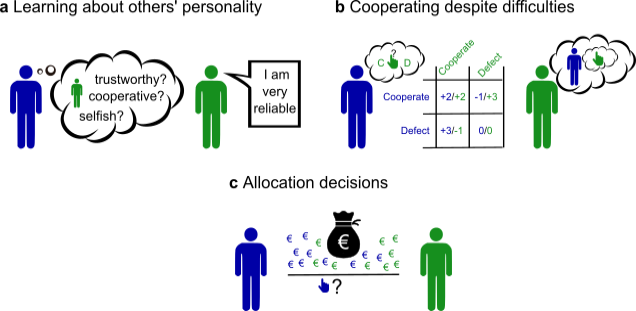A multimodal approach to human cooperation
The following schema illustrates the three aspects of cooperation to be investigated within the framework of the Emmy-Noether research group.
- (a) Before cooperating, humans usually learn about each others personality (by generalizing across similar traits).
- (b) The basic problems of cooperation itself are encapsulated in the prisoners dilemma (depicted payoff table). Mutual cooperation yields the best joint payoff but unilateral defection is tempting. Further difficulties arise when one person (green) is sometimes forced to defect but the other person (blue) does not know this.
- (c) Once cooperation is firmly established, partners have to decide how to share the benefits.
To address these aspects of human cooperation, the planned projects will draw on insights from my previous studies (see research topics below) and combine the following approaches: Game theory (especially notions from stochastic games and derivations of the Shapley value), computational modeling (related to Markov decision processes, reinforcement learning, risk-return models), fMRI (univariate model-based analyses and representational similarity analyses), pupillometry, virtual reality (VR), and testing of psychiatric patients, especially borderline personality disorder (BPD) patients.
Multisensory integration
In ongoing projects, Jan Gläscher and I harness representational similarity analyses of fMRI data to investigate how reward learning relates to the integration of multimodal stimuli (i.e., audiovisual stimuli).
Optimal versus heuristic decision-making
A series of (partly published) studies from my postdoc at the University of Zurich clarify how humans combine myopic heuristics and rationally optimal decision policies, which necessitate integrating over a multiple future steps (Korn & Bach, 2015; 2018). I developed complex decision-making tasks on the basis of Markov decision processes and compared novel decision-making models against standard economic models of valuation (using Bayesian model comparison). Results provide evidence for a conflict computation related to activity in medial prefrontal cortex that guides the trade-off between heuristic and optimal policies. Such multi-step decisions play an integral role in many approach-avoidance conflicts, which are sensitive to anxiolytic medication and lesions of the amygdala and the hippocampus (Korn, Vunder, Miró, et al., 2017; Bach, Korn, Vunder, Bantel, in press).
Results from Korn & Bach (2018) show that in a sequential foraging task humans combine a simple heuristic (called here p foraging success) with the optimal policy. The optimal policy and the uncertainty thereof relate to parts of the MPFC.
Apparent decision biases in social and non-social information processing
Studies from my Masters thesis in London and my PhD in Berlin demonstrate that humans process self-relevant information about their future or their character in an apparently irrational and positively biased way (Sharot*, Korn*, Dolan, 2011; Sharot, Guitart-Masip, Korn, et al., 2012; Korn, Prehn, Park, et al., 2012; see also Oganian, Heekeren, Korn, in press). In my PhD thesis, I developed a neurocognitive model that relates this type of biased information processing to the neural processing of social rewards and mentalizing (Korn, Prehn, Park, et al., 2012).
Follow-up studies show the relevance of these processes for psychiatric disorders, i.e., depression (Korn*, Sharot*, Walter, et al., 2014) and borderline personality disorder (Korn, La Rosée, Heekeren, et al., 2016a, 2016b) and also for cultural differences (as investigated during a research stay in Beijing; Korn, Fan, Zhang, et al., 2014).
In additional studies, my collaborators and specified some of the boundary conditions for other types of apparent decision biases, namely the self-related attributions (Korn*, Rosenblau*, Rodriguez Buritica, et al., 2016) and framing effects (Oganian*, Korn*, Heekeren, 2016; Korn, Ries, Schalk, et al., 2017; Korn, Heekeren, Oganian, 2018).
*equal contribution
Model-based approaches to pupillometry
Together with Dominik Bach, I developed model-based procedures for analyzing pupil responses. In a first step, we established and validated a parsimonious description of luminance-elicited pupil responses (on the basis of two response functions). This description furnishes a characterization of both prolonged and brief pupil responses (Korn & Bach, 2016). In a second step, we validated an analysis procedure for fear conditioning paradigms that provides better discrimination than previous methods (Korn, Staib, Tzovara, et al., 2016). These models have recently summarized within a review paper (Bach, Castegnetti, Korn, et al., in press).
Commitment to open science
I believe that science should be open and reproducible. Therefore, I have made data of my recent projects publicly available. My colleagues and I have pre-registered two recent studies (Korn, Ries, Schalk et al., 2017 and Oganian, Heekeren, Korn, 2018). We are thankful to the Center for Open Science for awarding us their pre-registartion prize for both of these studies.
Thanks to the efforts by Dominik Bach and many people in his lab, all developed models for analyzing psychophysiological data are incorporated in the MATLAB toolbox PsPM and most datasets are publicly available.
Furthermore, I feel honored to act as an academic editor for the open access journal PLoS One.
